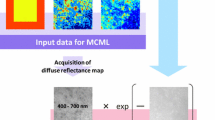Abstract
A method for recovering the spectrum of both the interface and the body reflectance for images composed of dichromatic surfaces is presented. An important assumption is that the spectrum of the interface component is the same as that of the illuminant. It is also assumed that the image is presegmented into dichromatic patches, that surfaces possess specularities, and that these highlights change geometrically differently from the shading. The method is based on minimizing the sum of squares of deviations from the dichromatic model over all the patches in the image, by using finite-dimensional linear models to approximate spectral functions. We point out shortcomings in the accuracy of such models when specularities are present in images. Results are presented for synthesized images made up of shaded patches with highlights. It is shown that the method does reasonably well in recovering interface and body colors as well as the illuminant spectrum and body spectral reflectance function.
Similar content being viewed by others
References
S.A. Shafer, “Using color to separate reflection components,”Color Res. Appl., vol. 10, 1985, pp. 210–218.
H.-C. Lee, E.J. Breneman, and C.P. Schulte, “Modeling light reflection for computer color vision,”IEEE Trans. Patt. Anal. Mach. Intell., vol. 12, 1990, pp. 402–408.
D. Forsyth, “A novel algorithm for color constancy,”Int. J. Comput. Vis., vol. 5, 1990, pp. 5–36.
G.J. Klinker, S.A. Shafer, and T. Kanade, “Color image analysis with an intrinsic reflection model,” inProc. Second Int. Conf. on Computer Vision, Institute of Electrical and Electronics Engineers, New York, 1988, pp. 292–296.
H.-C. Lee, “Method for computing the scene-illuminant chromaticity from specular highlights,”J. Opt. Soc. Am. A, vol. 3, 1986, pp. 1694–1699.
G. Wyszecki and W.S. Stiles,Color Science: Concepts and Methods, Quantitative Data and Formulas, 2nd ed., Wiley, New York, 1982.
F. Tong and B.V. Funt, “Specularity removal for shape from shading,” inProc. Vision Interface 1988, Edmonton, Alberta, Canada, 1988, pp. 98–103.
F. Tong and B.V. Funt, “Removing specularities from color images for shape from shading,” inComputer Vision and Shape Recognition, A. Krzyzak, ed., World Scientific, Singapore, 1989.
S. Tominaga and B.A. Wandell, “Standard surface-reflectance model and illuminanat estimation,”J. Opt. Soc. Am. A, vol. 6, 1989, pp. 576–584.
B.V. Funt and M.S. Drew, “Color space analysis of mutual illumination,”IEEE Trans. Patt. Anal. Mach. Intell., to appear.
H.-C. Lee, “Illuminant color from shading,Proc. Soc. Photo-Opt. Instrum. Eng., vol. 1250, 1990, pp. 236–244.
M. D'Zmura and P. Lennie, “Mechanisms of color constancy,”J. Opt. Soc. Am. A, vol. 3, 1986, pp. 1662–1672.
R. Gershon, A.D. Jepson, and J.K. Tsotsos, “Highlight identification using chromatic information,” inProc. First Int. Conf. on Computer Vision, Institute of Electrical and Electronics Engineers, New York, 1987, pp. 161–170.
R. Bajcsy, S.W. Lee, and A. Leonardis, “Color image segmentation with detection of highlights and local illumination induced by inter-reflections,” inProc. 1990 Int. Conf. on Pattern Recognition, Vol. 1, Institute of Electrical and Electronics Engineers, New York, 1990, pp. 785–790.
G.J. Klinker, S.A. Shafer, and T. Kanade, “The measurement of highlights on color images,”Int. J. Comput. Vis., vol. 2, 1988, pp. 7–32.
M.S. Drew and B.V. Funt, “Natural metamers,”CVGIP: Image Understanding, vol. 56, 1992, pp. 139–151.
B.A. Wandell, “The synthesis and analysis of color images,”IEEE Trans. Patt. Anal. Mach. Intell., vol. 9, 1987, pp. 2–13.
J. Ho, B.V. Funt, and M.S. Drew, “Separating a color signal into illumination and surface reflectance components: Theory and applications,”IEEE Trans. Patt. Anal. Mach. Intell., vol. 12, 1990, pp. 966–977.
M.S. Drew and B.V. Funt, “Variational approach to interreflection in color images,”J. Opt. Soc. Am. A, vol. 9, 1992, pp. 1255–1265.
D.B. Judd, D.L. MacAdam, and G. Wyszecki, “Spectral distribution of typical daylight as a function of correlated color temperature,”J. Opt. Soc. Am., vol. 54, 1964, pp. 1031–1040.
J. Cohen, “Dependency of the spectral reflectance curves of the Munsell color chips,”Psychon. Sci., vol. 1, 1964, pp. 369–370.
L.T. Maloney and B.A. Wandell, “Color constancy: A method for recovering surface spectral reflectance,”J. Opt. Soc. Am. A, vol. 3, 1986, pp. 29–33.
L.T. Maloney and B.A. Wandell, “Color imaging process,” U.S. Patent 4648051, 1987.
L.T. Maloney, “Evaluation of linear models of surface spectral reflectance with small numbers of parameters,”J. Opt. Soc. Am. A, vol. 3, 1986, pp. 1673–1683.
J.L. Dannemiller, “Spectral reflectance of natural objects: How may basis functions are necessary?J. Opt. Soc. Am. A, vol. 9, 1992, pp. 507–515.
L.T. Maloney, “Computational approaches to color constancy,” Ph.D. thesis, Stanford University, Stanford, CA, 1985.
B.V. Funt, J. Ho, and M.S. Drew, “Method and apparatus for determining ambient light and surface reflectance,” U.S. Patent 4,992,963, February 12, 1991.
D.B. Judd and G. Wyszecki,Color in Business, Science and Industry, 3rd ed., Wiley, New York, 1975.
E.L. Krinov, “Spectral reffectance properties of natural formations,” Tech. Translation TT-439, National Research Council of Canada, Ottawa, 1947.
B.-T. Phong, “Illumination for computer generated pictures,”Comm. ACM, vol. 18, 1975, pp. 311–317.
J.D. Foley, A. van Dam, S.K. Feiner, and J.F. Hughes.Computer Graphics: Principles and Practice, 2nd ed., Addison-Wesley, Reading, MA, 1990.
Eastman Kodak Co.,Kodak Filters for Scientific and Technical uses, 2nd ed., Eastman Kodak Co., Rochester, NY, 1981.
M. Bertero, T. Poggio, and V. Torre, “III-posed problems in early vision,” Memo 924, Artificial Intelligence Laboratory, Massachusetts Institute of Technology, Cambridge, MA, 1987.
S. Tominaga and B.A. Wandell, “Component estimation of surface spectral reflectance,”J. Opt. Soc. Am. A, vol. 7, 1990, pp. 312–317.
S. Tominaga, “Surface identification using the dichromatic reflection model,”IEEE Trans. Patt. Anal. Mach. Intell., vol. 13, 1991, pp. 658–670.
S. Kawata, K. Sasaki, and S. Minami, “Component analysis of spatial and spectral patterns in multispectral images, I: Basis,”J. Opt. Soc. Am. A vol. 4, 1987, pp. 2101–2106.
Author information
Authors and Affiliations
Additional information
This work was supported in part by grants from the Centre for Systems Science of Simon Fraser University.
Rights and permissions
About this article
Cite this article
Drew, M.S. Optimization approach to dichromatic images. J Math Imaging Vis 3, 187–203 (1993). https://doi.org/10.1007/BF01250529
Issue Date:
DOI: https://doi.org/10.1007/BF01250529




